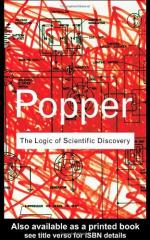|
This section contains 813 words (approx. 3 pages at 400 words per page) |

|
Part II: Chapter 3, Theories Summary and Analysis
Systems of theories comprise empirical science. Therefore, a logic of science is a theory of theories. Theories are used to capture and explain the world. These theories or natural laws are continually being refined to become better explanatory tools. Scientific theories are universal statements. Popper says that the frequently-made distinction between universal statements and singular statements, that theories are universal while singular statements are concrete, is not a useful distinction. He finds this distinction less than useful because it seeks to constrain theories under a label of their instrumental uses. Instead, the goal is to look for universal theories and a coherent theoretical system. Theories are guides to explanations of the world and its phenomena. Further, theories are often looked to for predictions.
Issues surrounding causal explanations arise when considering predictions. Causality depends upon both...
(read more from the Part II: Chapter 3, Theories Summary)
|
This section contains 813 words (approx. 3 pages at 400 words per page) |

|




